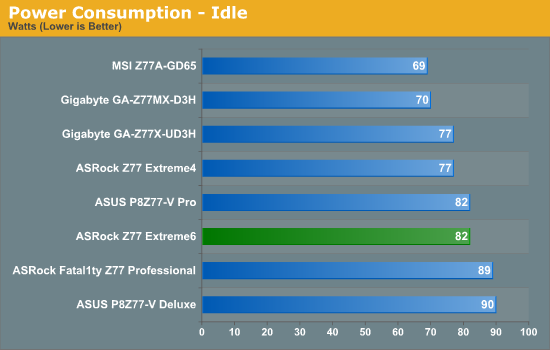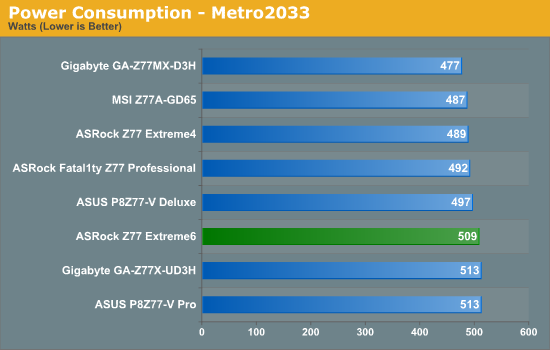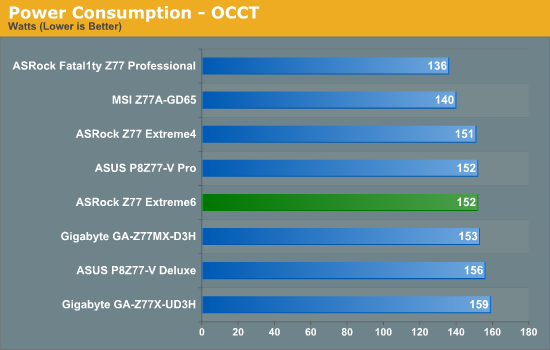ASRock Z77 Extreme6 Review: Legacy Bites Back
by Ian Cutress on July 13, 2012 2:00 PM EST- Posted in
- Motherboards
- ASRock
- Z77
Test Setup
| Processor |
Intel Core i7-3770K ES 4 Cores, 8 Threads, 3.5 GHz (3.9 GHz Turbo) |
| Motherboards |
ASRock Z77 Extreme4 ASUS P8Z77-V Pro Gigabyte GA-Z77X-UD3H MSI Z77A-GD65 ASUS P8Z77-V Deluxe ASRock Fatal1ty Z77 Professional Gigabyte GA-Z77MX-UD3H ASRock Z77 Extreme6 |
| Cooling | Intel All-in-One Liquid Cooler |
| Power Supply | OCZ 1250W Gold ZX Series |
| Memory |
GSkill RipjawsZ 4x4 GB DDR3-2400 9-11-11 Kit GSkill TridentX 2x4 GB DDR3-2666 11-13-13 Kit |
| Memory Settings | XMP (2400 9-11-11) |
| Video Cards |
ASUS HD7970 3GB ECS GTX 580 1536MB |
| Video Drivers |
Catalyst 12.3 NVIDIA Drivers 296.10 WHQL |
| Hard Drive | Micron RealSSD C300 256GB |
| Optical Drive | LG GH22NS50 |
| Case | Open Test Bed - CoolerMaster Lab V1.0 |
| Operating System | Windows 7 64-bit |
| SATA Testing | Micron RealSSD C300 256GB |
| USB 2/3 Testing | OCZ Vertex 3 240GB with SATA->USB Adaptor |
Power Consumption
Power consumption was tested on the system as a whole with a wall meter connected to the OCZ 1250W power supply, while in a dual 7970 GPU configuration. This power supply is Gold rated, and as I am in the UK on a 230-240 V supply, leads to ~75% efficiency > 50W, and 90%+ efficiency at 250W, which is suitable for both idle and multi-GPU loading. This method of power reading allows us to compare the power management of the UEFI and the board to supply components with power under load, and includes typical PSU losses due to efficiency. These are the real world values that consumers may expect from a typical system (minus the monitor) using this motherboard.



The Z77 Extreme6 does not seem to pull anything special out of the bag for power delivery, matching some of the more high performance models from ASUS and Gigabyte.
POST Time
Different motherboards have different POST sequences before an operating system is initialized. A lot of this is dependent on the board itself, and POST boot time is determined by the controllers on board (and the sequence of how those extras are organized). As part of our testing, we are now going to look at the POST Boot Time - this is the time from pressing the ON button on the computer to when Windows starts loading. (We discount Windows loading as it is highly variable given Windows specific features.) These results are subject to human error, so please allow +/- 1 second in these results.

ASRock always does quite well on boot timings, taking all the top spots. It is assumed that ASRock has the least amount of 'check and verification' tools compared to their competitors, which can increase boot time.
Overclocks
Here at AnandTech we want to provide quick and easy ways to determine if a board is good for you (with in-depth analysis of course). So here is a quick round up of our overclocking results. Overclocks are tested for stability with PovRay and OCCT - while these may not be the most strenuous of stability tests, it does offer a quick check for memory errors under high load (and also balances testing time with getting the next board on for review!).
|
CPU Speed (MHz) |
Voltage (Volts) |
PovRay Peak Temp (ºC) |
OCCT Peak Temp (ºC) |
Notes | |
|
ASRock Fatal1ty Z77 Professional |
4700 | 1.200 | 89 | 89 | PLL Overvoltage enabled |
|
ASRock Z77 Extreme4 |
4700 | 1.175 | 86 | 86 | LLC Level 1 |
|
ASRock Z77 Extreme6 |
4700 | 1.175 | 81 | 82 | LLC Level 1 |
|
ASUS P8Z77-V Deluxe |
4700 | 1.225 | 89 | 84 | PLL Overvoltage enabled |
|
ASUS P8Z77-V Pro |
4700 | 1.200 | 83 | 86 | PLL Overvoltage enabled |
|
Gigabyte Z77X-UD3H |
4700 | 1.200 | 82 | 86 | LLC Extreme |
|
Gigabyte Z77MX-D3H |
4700 | 1.200 | 80 | 84 | LLC Extreme |
|
MSI Z77A-GD65 |
4700 | 1.250 | 90 | - | PLL Overvoltage enabled |










35 Comments
View All Comments
nubie - Saturday, July 14, 2012 - link
Yes, a COM port and Serial port are generally the same thing.I much prefer Parallel, because I am "bit-banging" to program an Atmega micro-controller, a I2C EEPROM, or an SPI EEPROM.
Although I do have a couple Packard Bell Fast Media Infrared (FMIR) receivers that demand a COM port, as does the (sadly lacking drivers newer than Win98) 6-axis Spacetec Orb controller.
Meaker10 - Saturday, July 14, 2012 - link
Without looking at the specs the mini slot is pci-e (for wifi) as it is half height and msata slots need to be full height.repoman27 - Saturday, July 14, 2012 - link
I thought one of the features of the Z77 chipset was that you could select between 1 x16, 2 x8, or 1 x8 + 2 x4 for the PCIe 3.0 lanes coming off of the CPU? In which case you wouldn't need an additional PCIe switch and all three cards would get at least 32 Gbps of PCIe bandwidth...Also, Ian, you seem to have some persistent dyslexia going on when it comes to the model names of PLX's PCIe switches; it's "PEX 8747", not "PXE 8747". There are other options available as well, such as the smaller, cheaper PEX 8724, which would have allowed them to offer effectively 3 x8 PCIe 3.0 slots.
scott967a - Saturday, July 14, 2012 - link
Do you guys ever test wake on lan or other wake up functions? Reason being for the first time I thought I would set up an old sys using Abit P35 Pro for WoL with fail result. Not sure if it is operator error or MB/BIOS problem but searching online doesn't yield much info on WoL performance.529th - Sunday, July 15, 2012 - link
Thank you for including a DPC latency test. Thank you Thank you Thank you! ha...Which app are you using to check DPC latency, btw?
Please include DCP latency testings in your future Motherboard testings as well. I will be jumping on the Haswell wagon when it comes through town.
Cheers
529th - Sunday, July 15, 2012 - link
And also include the BIOS that it's being tested on. Thanks :)IanCutress - Sunday, July 15, 2012 - link
As you can perhaps tell from our DPC Graph, we've been testing it quite a while. And in the explanation of said test, I do mention the program I use - DPC Latency Checker. Quick Google will find it. Currently I'm rarely finding a motherboard on a mainstream chipset that severely fails it - usually it is the included monitoring software that causes peaks of 2000+. If this happens, disable your monitoring software or update the BIOS.Ian
hansmuff - Sunday, July 15, 2012 - link
If I were to release a legacy connector board, I would most certainly at the very least have two serial ports in the back, or one plus header. I would also most certainly include a parallel port header on the motherboard, and include brackets for serial and parallel headers.Floppy and IDE is all good and well, but one serial port and no parallel port are oversights to me for such a board.
adrianlegg - Monday, July 16, 2012 - link
Hello,I just had some random idea,
Couldn't You use, some kind of electric stopwatch, which can be started/paused with any current, connect it to poweron wire (from button), and then instead of using Windows, use some custom linux bootloader with option to, for example, use pc speaker, which signal would be used to stop mobo?
I lack proper knowledge to design that system, aside from components (2 wires, custom bootloader, and stopwatch/some multimeter with time option)
Excuse me if that's completely ignorant, but I think that could increase precision of Your timings.
Thx for all good work.
adrianlegg - Monday, July 16, 2012 - link
(ofc not "stop mobo" but "stop timing")